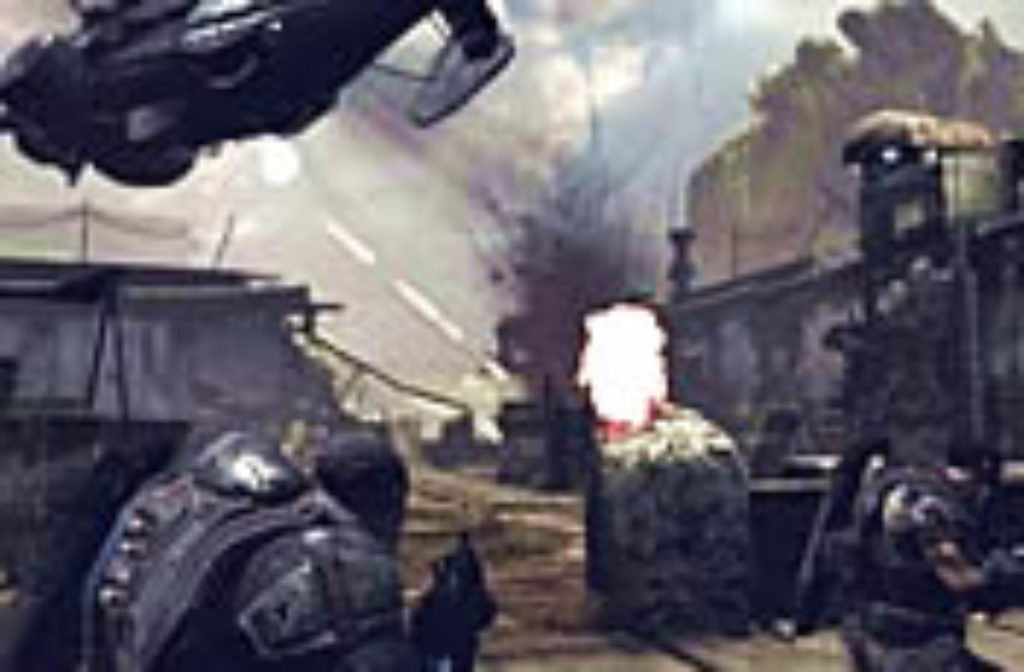
I don’t know how many times I’ve found myself in vicious, close-in firefights with marauding aliens and wished, If only my machine gun had a chain saw too, I might make it. OK, I’ve never thought that. But the first time I saw such a weapon in Gears of War, I did think, This might come in handy.
And it does in the hands of a formidable soldier named Marcus Fenix. His task, along with several other warriors in his squad, is to repel the Locust Horde. This nefarious alien race existed undetected beneath the surface of the planet Sera for decades as human beings colonized it. Then, without warning, Emergence Day marked the Horde’s angry arrival on the surface.
Suffice it to say the humans didn’t fare well.
Fourteen years later, a contingent of desperate-but-determined soldiers still struggles to force the Horde back into the hole it crawled out of—one bullet at a time.
101 Ways to Kill the Horde
Gears of War is the It Game of the moment for Microsoft’s Xbox 360. This third-person shooter is among the first titles to exploit the console’s full graphic potential. Rich visual details and exhilarating gameplay have reviewers singing its praises as the heir apparent to the mighty Halo franchise.
It’s too bad, then, that nowhere is the game’s crisp, photorealistic detail more obvious than in its grisly battles. Fenix and Co. must work their way through decimated urban environments, engaging enemies as they go. Sometimes, Horde soldiers (with ominous names such as Drones, Boomers, Beserkers, Seeders and Corpsers) lurk in fortified positions. More often, the pesky critters emerge from sinkhole-like pits that open without warning.
As in Halo, success depends in part upon choosing the right weapon to blast these beasties back to Sera’s nether regions. And so we’re back to Fenix’s go-to weapon, a lethal machine gun/chain saw hybrid dubbed the Lancer Assault Rifle. Plunging the Lancer’s so-called “Chainsaw Bayonette” into a Locust Drone not only plies limb from alien limb, it actually splatters the game’s “camera” lens with blood—just like a cheesy horror movie. Fenix also relies upon grenades, a sniper rifle and the Hammer of Dawn, with which he can call down a massively destructive laser attack from airborne allies.
In addition to raw firepower, strategy and tactics also play critical roles in Gears. Even the easiest targets take a lot of punishment (spraying gallons of blood and chunks of flesh as they do so) before going down. Accordingly, the game’s realistic combat sequences require players to take cover behind various barriers, as well as working as a team to flank enemy positions. Gung-ho frontal assaults are suicidal requests to replay a given level.
Of course the thought of that suicidal request slams us right back into a discussion about blood. If Fenix gets caught unprotected in the open, enemy ammo doesn’t simply kill him, it often leaves his mangled corpse in a sickening pile of disconnected limbs. Without hesitation I can say that Gears of War is easily one of the most graphically violent games I’ve ever played. And even if you engage the option to tone down the blood and profanity levels—a feature intended to make the game more appropriate for younger players—Gears remains intensely violent.
What kind of language is in need of toning down? Most vulgar dialogue is directed at alien assailants, such as, “Eat s— and die!” or “Sons a’ b–ches!” Other times, profanity is born of desperation (“G–d–mit, help us out here!”).
“Splattering Blood Never Looked So Beautiful.”
Some reviewers practically get breathless describing their experience playing Gears. Bryn Williams of GameSpy writes, “I’m smitten with Gears of War and all its glorious, horrific violence, blood and anarchy.” Adds GamesRadar contributor Gabe Graziani, “Splattering blood never looked so beautiful.” The fact that so many others are piling on the superlatives (“astonishing,” “epic,” “superb,” “stunning,” “unparalleled,” “thrilling,” “a visual and visceral masterpiece”), and the fact that the game has already moved 3 million units worldwide mean we will likely see War parties popping up among its fans, just as happened when Halo hit its zenith.
For my part, I’ll confess that Gears is one of those games that constantly eggs you on into playing “just one more level”—and then you look up and realize you’ve been playing for hours. It’s immersive, to say the very least.
And therein lies the rub. Its creators have crafted a game that makes reality pale by comparison. Blasting the Horde into submission can be so exhilarating that, well, you really just don’t feel like doing much else (another trait Gears shares with Halo). The game’s graphic violence is jarring at first. Then, gradually, you “acclimate” to it, not thinking too much about what it means to watch your guy get his guts blown out—again.
But are those bloody images, no matter how artfully rendered, really something that any of us should “get used to”? Psychologists are still working out what, exactly, exposure to such pulse-pounding violence does to a person’s brain and psyche. But most report broadly similar findings: Games like Gears of War desensitize players to other violence and numb their ability to think critically about the consequences of their decisions—calling into question the decision to plunk down $60 just to find out.

After serving as an associate editor at NavPress’ Discipleship Journal and consulting editor for Current Thoughts and Trends, Adam now oversees the editing and publishing of Plugged In’s reviews as the site’s director. He and his wife, Jennifer, have three children. In their free time, the Holzes enjoy playing games, a variety of musical instruments, swimming and … watching movies.